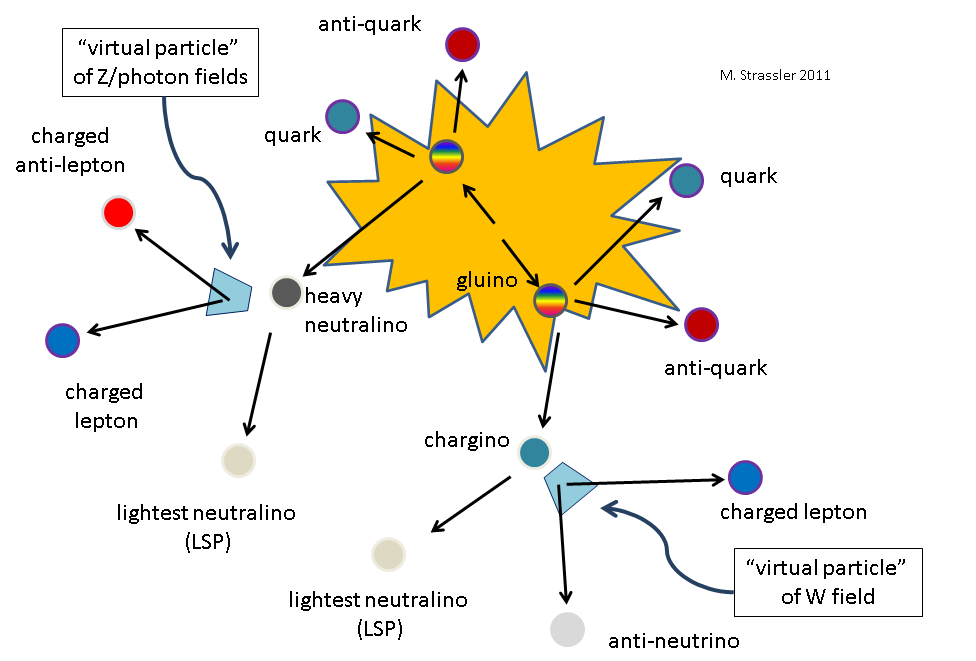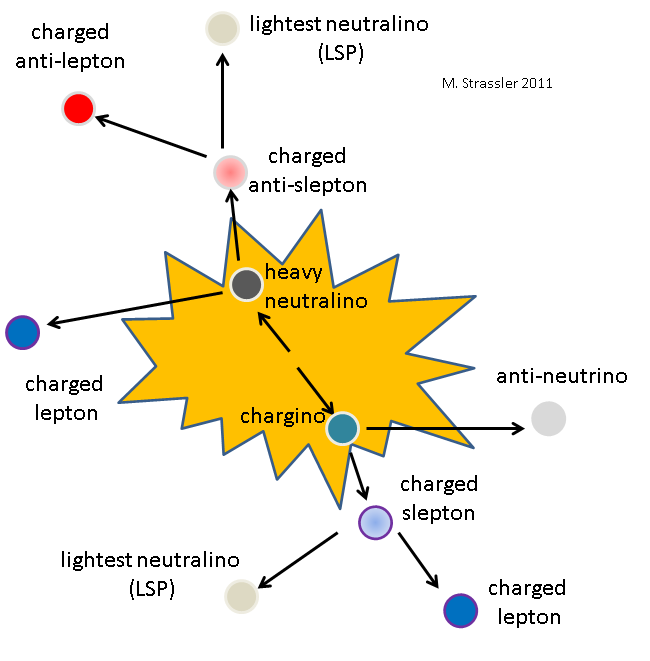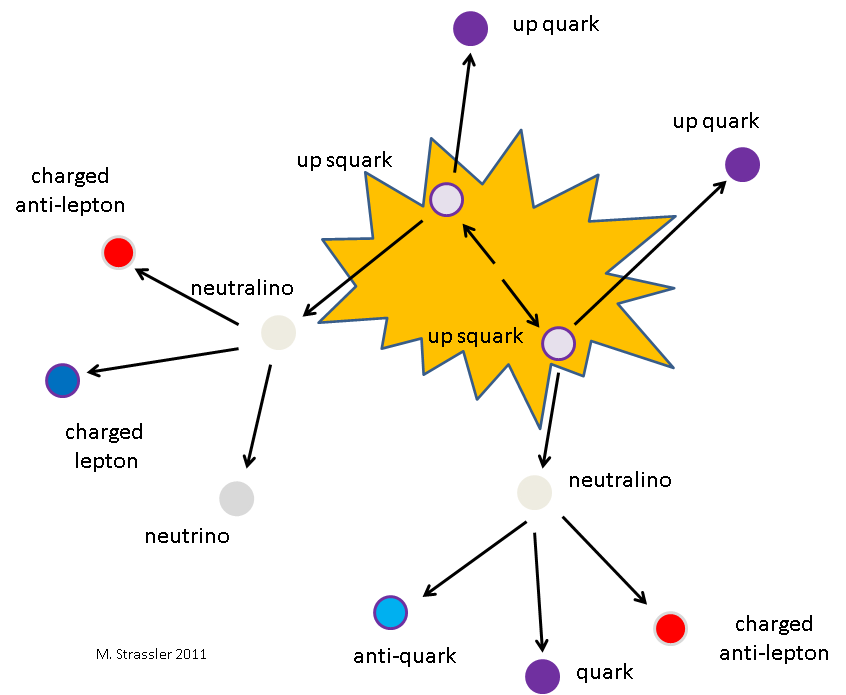By “multi-lepton event” people traditionally mean a particle collision in whose debris are found three or more charged leptons and/or anti-leptons of any “flavor” (electron, muon or tau.) (The leptons should be “isolated” — at least, far from anything that looks like a jet.) Supersymmetry is commonly a source of such events, at rates that can make it detectable above the backgrounds from known particle physics (as predicted by the equations of the Standard Model of particle physics.)
How does supersymmetry do it? There are actually many ways. In one, a pair of particles that carry strong nuclear forces (such as a gluino, the gluon’s superpartner) are produced, with a relatively high rate, and these particles decay to quarks and/or antiquarks plus a chargino (a mixture of superpartners of the W particles and the charged Higgs particle that arises in supersymmetry) or a neutralino (a mixture of superpartners of the photon, Z, and the neutral Higgs particles.) The chargino and neutralino can then in turn decay to a lighter neutralino [the lightest superpartner, or “LSP”] plus a W and Z particle, or plus W and Z virtual particles, in the process producing three (and very rarely four) leptons/anti-leptons. See Figure 1.

However, note that such events — and similar events that arise in other variants of supersymmetry, would typically produce multiple high-energy jets (from the quarks and antiquarks in the gluino decay) and also large momentum imbalance (“missing energy” [really, transverse momentum, not energy] or “MET”) from the two undetectable LSPs. There is no evidence that the recent CMS search for multi-lepton events, which has an interesting though not convincing excess of events, involves events with these characteristics — especially since in these scenarios, other searches for supersymmetry, such as searches for jets and MET, and perhaps a lepton as well, would have a good chance (though not a guarantee) of finding signs of supersymmetry first. Meanwhile, direct production of the charginos and neutralinos tends to be a bit too small to be consistent with CMS’s excess, though this has loopholes. In fact, here’s one.

Another way that supersymmetry can do it — and this one is almost but not quite unique to supersymmetry — is through the presence of lightweight superpartners of the charged and neutral leptons. (Many speculative theories have something like partners for the heavy particles — for W and Z particles, higgs particles, top quarks, and maybe bottom quarks and taus — but lack lightweight partners for the other leptons.) This scenario can allow supersymmetry to produce many multi-lepton events even without use of gluinos or squarks to get a high production rate. The big problem with producing multi-lepton events comes from the fact that W and Z particles (or virtual particles) don’t produce leptons all the time; the W does only 30% of the time, and the Z does less than 10%. So of all events with a W and a Z, only a few percent produce three leptons. But there’s a way to get leptons a large fraction of the time. If (see Figure 2) a chargino and neutralino are produced together, and these decay to an a charged lepton or neutrino and a superpartner of a charged lepton or neutrino, following which the superpartner decays itself to a charged lepton or neutrino plus an LSP neutralino, then every time a chargino and neutralino are produced one obtains four particles that are charged leptons or neutrinos (or their antiparticles.) The chance of getting three charged leptons is now as high as 50% in these events. In such cases, a multi-lepton search stands a good chance of being the one that first sees signs of supersymmetry.
Yet other way to have many leptons in supersymmetry is to have R-parity violation (Figure 3). In this case, the LSP may often decay to three particles, one or two of which are charged leptons (or anti-leptons.) Here the missing-energy signal is largely absent because the LSP decays, so standard search strategies for supersymmetry will fail. Again a multi-lepton search may be one of the best strategies in this case.

This by no means exhausts the list! There are a number of other possibilities.


7 Responses
Professor,
I’m having a hard time keeping track of what particle is which and with which properties. Can you point me to a summary, pictorial or otherwise of what particles are superpartners of what standard particles, generally speaking?
Dear Matt,
Would it be correct to say that if the charged sleptons were heavy O(10) TeV, the neutralino and chargino two-body decays in Fig. 2 would be simply replaced by the effective three-body decays via virtual sleptons with the same end result?
Not quite, because if you push the slepton masses up that high, typically the W and Z particles would dominate in the decays, similar to figure 1. However what you say could be true if the sleptons were just a little bit too heavy to appear as real particles.
Thank you, Matt! If I understand you correctly, the end result would still contain three charged leptons, two LSPs and an anti-neutrino, it’s just that the decays of the chargino and neutralino would go via the Z and W. Correct?
Almost — because if they go by a W or a Z, then the chances are very good that one or both W and Z will decay to a quark and an anti-quark, producing two jets instead; or that the Z will decay to neutrinos. In other words (as I emphasized in the text) this situation drastically reduces the number of three-lepton events that arise.